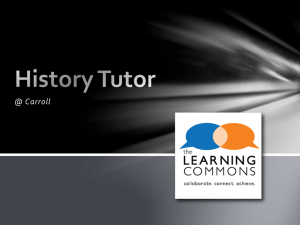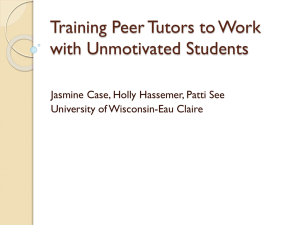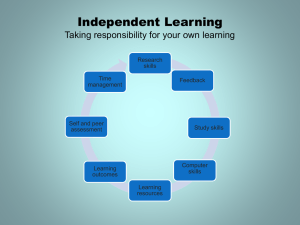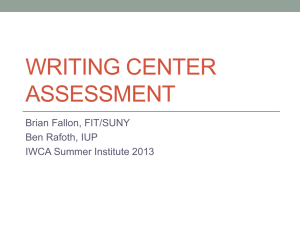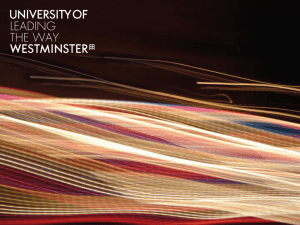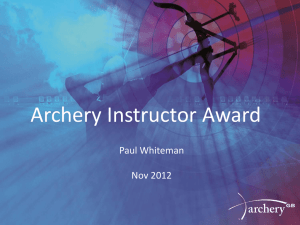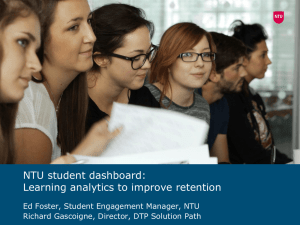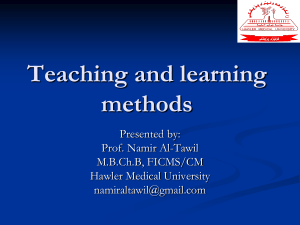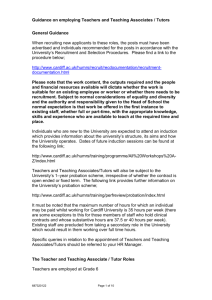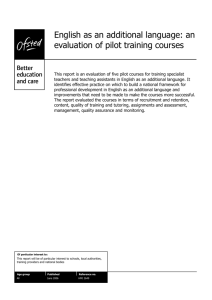Beth Dickson`s PowerPoint
advertisement
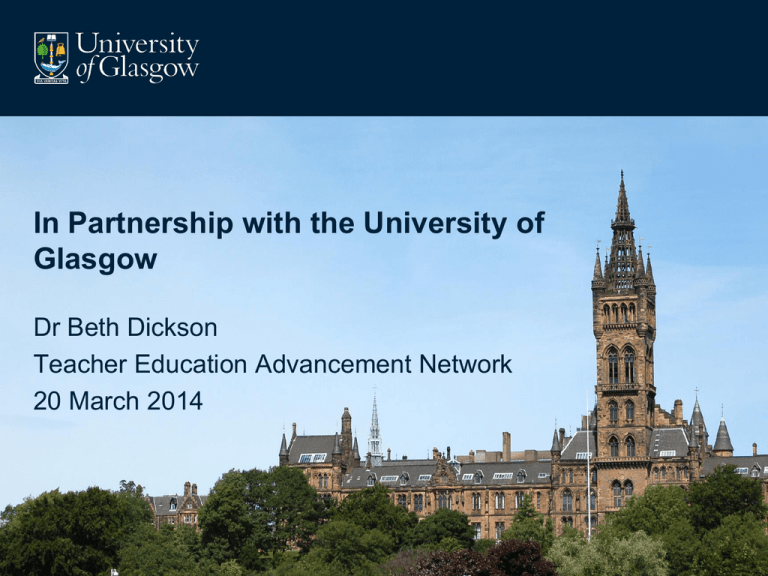
In Partnership with the University of Glasgow Dr Beth Dickson Teacher Education Advancement Network 20 March 2014 Teaching Scotland’s Future (2011) “Seventy-eight per cent of respondents to our online survey (n=2381) indicated that the support they received from the school during placements was 'very effective or 'effective'. Fifty-one per cent said that the support from their university was 'very effective' or 'effective', but 20% said support from the university was 'very ineffective' or 'ineffective'. We need to find ways of encouraging and assuring a more consistently high quality of placements within initial teacher education.” (p.43) “Here’s one I prepared earlier...” • Scottish Government funding for partnership • Set up a partnership with Glasgow City Council and some of their schools – – – – – university tutors in the field for the duration of the placements seminars learning rounds joint reporting tutors assessed across sectors and disciplines Aspirations Clear definition of roles and responsibilities of all partners Development should be organic Teachers and schools valuing and being valued in their role in partnership development Immediate and in-depth evaluation of partnership activities Enhanced support Improved communication Planning Meetings with Steering Group Identification of volunteer student group Meeting of tutors with student group Clarification of programme Formation and ongoing work of research team Overview of Project: structure & content • Professional Development Seminars • Learning Round Observations • Joint Assessment Process Seminars • Wednesday 9-12 – students gather as a learning community • Seminar topics: Learning Round Process, Communication, Reflective Evaluation, Positive Relationships • Seminar topic – theme of Learning Round • Opportunity for students to communicate with each other and with tutors Learning Round Observations Students placed in small groups (3-5) 1 student teacher is observed by LR group, class teacher and tutor Nonjudgmental observations (20 minutes) Post observation discussion – focus on observer’s practice Joint Assessment Less emphasis on single observed visit Information on student’s progress gathered through Learning Rounds, ongoing communication and final assessed observation Tutor and class teacher/principal teacher devise single report and agree grades Practicalities • Additional tutor commitments • Timetabling of observations • Time required for assessed visits and feedback • Development of shared language Strengths • Increased support for students • Quick resolution of problems • Immediate and enhanced link between theory and practice • Improved communication channels • Increased opportunities for critical reflection • Stronger emphasis on valued role of school partners • Agreed assessment of student Outcomes from the first evaluation To co-construct and implement a new collaborative school (and community) based partnership approach…; Yes, for student teachers… To establish closer communication, shared understanding and relationships; Mutual engagement, but communication.. To build capacity in the profession to engage with effective practice-based and evidence -informed models of professional learning… Power of LRs and seminars To identify and evaluate the particular benefits for partnership, for learning and professional development and ITE/CPD policy Yes, but limited so far – complexity To identify and evaluate the benefits of the co-construction, co-learning and co-inquiry approach…; Yes, but… and sec. Subjects To identify the methods by which scholarly output and learning opportunities … can be increased, and with what impact. We’ll see… 12 Evaluations and Actions Cross-cutting themes Evaluation 1 Of pilot cluster 20102011 Need for clearer 1.Communication Response Evaluation 2 Of ‘pilot’ cluster and 2 new clusters Earlier written information and meetings for both new clusters Manage expectations guidance 2. Level and types of support 3. Professional Learning *Seminars *Learning Rounds *Joint reporting 4. Professional roles and identities 5. Cultural change Benefits of peer support Students wanted more support Teachers felt students got more support All parties thought that students benefitted Some teacher did Both tutors did Students felt their id.s were strengthened Tutors, HTs and teachers did Rolled out to 2 new clusters ‘crit’ lesson Concerns of secondary subject tutors ‘pilot’ cluster – reduction in requests new clusters – requests for earlier communication University tutors not in scheme felt alienated Student expectation still high University tutors not involved felt need for secondary subject visits All parties thought that students benefitted Teacher hesitation about need for secondary subject visit Encouraged tutors to encourage teachers to give seminars New relationships between tutors and teachers: ‘real mentors’ No action Series of seminars, meetings and No mention Increased in severity Leadership Evaluation 1 Autumn 2011 For session 2010-2011 Action/Response Policy Experience Scottish Government Funding (pp.5-13) Crit lesson 2. Clarity and realism of purpose 1. Communication 2. Support 4. Prof Learning Extension Development Intensive work with local authority partner 3. Commitment and ownership 5.Cultural change No action apart from 2 and 5. Concerns of secondary subject tutors 6 principles of partnership working (Hudson and Hardy, 2002) 1. Need for partnership Evaluation 2 Autumn 2012 for session 20112012 Joint appointment with local authority Discussions with University of Strathclyde Brief mention of the necessity of local authority commitment (p,) Importance of leadership Second cycle requests reduced First cycle requests similar 4. Developing and maintaining trust No mention in cc Mentions of hesitancy Second cycle in first cluster and 2 new clusters Positive expressions of trust 5. Establishing clear 1. Communication 2. Support 4. Prof id Earlier information Earlier meetings Intensive work with local authority partner Second cycle – embedded First cycle – conventional 2. Support Fact of Evaluation Teacher attitudes Fact of Evaluation Fact of tutor visibility Teacher attitudes Fact of evaluation and robust partnership arrangements 6. Monitoring, review and organisational learning Donald McIntyre (2006) • CNAA’s Undergraduate Initial Training Board (1978-1984) • Collaborative Project on Teacher Education (1978) between University of Stirling and Central Region • The Primary Teaching Practice Project at Moray House College (1980-1982) “that teacher educators...had the opportunity to shape the nature of the reforms to be made; but, with relatively few exceptions, they failed to take this opportunity and introduced reforms only minimally and reluctantly” (2006:8) Resolution • 86% of students had said that they found the partnership model of greater benefit to them than the conventional model • Continuing arguments • Supportive university procedures and personnel Next Steps • Now working with University of Strathclyde and 8 local authority clusters – Benefits for teacher learning • Won £300,000 from Scottish Government for posts to embed partnership processes Remaining Question: who are the teacher educators? • TSF (2011) • Complementary roles for university-based and schoolbased teacher educators • (Staffing in transition) • Career-long teacher learning • Masters-level profession • School-based professional learning for teachers • Professional Update (Standard for Career-long Learning) Conclusion • Visionary, entrepreneurial leadership • Determination to innovate • Ability to command resource • Credibility with partners BUT • Same world, same pressures political and financial • Realities of research-intensive universities • How similar? • How different? References Donaldson, G (2011) Teaching Scotland’s Future. Edinburgh: Scottish Government. Hudson, B., Hardy, B. and Waddingham, E. (2002) Assessing Strategic Partnerships: The Partnership Assessment Tool. London: Office of the Deputy Prime Minister.
